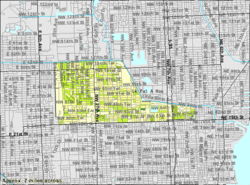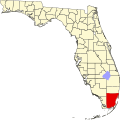West Little River, Florida | |
|---|---|
 Location in Miami-Dade County and the state of Florida | |
 U.S. Census Bureau map showing CDP boundaries | |
| Coordinates: 25°51′25″N80°14′13″W / 25.85694°N 80.23694°W | |
| Country | |
| State | |
| County | |
| Area | |
• Total | 4.66 sq mi (12.07 km2) |
| • Land | 4.59 sq mi (11.88 km2) |
| • Water | 0.07 sq mi (0.19 km2) |
| Elevation | 7 ft (2 m) |
| Population | |
• Total | 34,128 |
| • Density | 7,441.78/sq mi (2,873.24/km2) |
| Time zone | UTC-5 (Eastern (EST)) |
| • Summer (DST) | UTC-4 (EDT) |
| ZIP Codes | 33147, 33150 (Miami) |
| Area codes | 305, 786, 645 |
| FIPS code | 12-76487 [3] |
| GNIS feature ID | 1867230 [4] |
West Little River is a census-designated place (CDP) in Miami-Dade County, Florida, United States. It is part of the Miami metropolitan area of South Florida. The population was 34,128 at the 2020 census. [2]
Contents
- Geography
- Demographics
- 2020 census
- 2010 census
- 2000 census
- Government and infrastructure
- Education
- Elementary schools
- Middle schools
- High schools
- Colleges and universities
- Libraries
- Transportation
- References
Most of West Little River was originally a neighborhood of the city of Miami when it was annexed into the city in 1925. [5] With the arrival of the Great Depression, Miami gave up its jurisdiction and West Little River became an unincorporated area of Miami-Dade County. [5]

